Business Law Report: UK Business Law and Legal Structures
VerifiedAdded on 2020/11/23
|11
|3624
|472
Report
AI Summary
This report provides a comprehensive overview of UK business law, beginning with an introduction to the legal system and its evolution. It details the sources of law in the UK, including legislation, case law, and European Union law, and examines the role of the government in law-making. The report further analyzes the impact of contract, company, and employment law on businesses, providing examples of how these laws affect operations. Different types of legally formed business organizations, such as sole proprietorships, partnerships, co-operative organizations, and limited liability companies, are then explored, along with their management and funding aspects. Finally, the report discusses legal solutions for resolving business disputes, offering a holistic understanding of the legal landscape for businesses in the UK. The report is available on Desklib, a platform providing AI-based study tools for students.
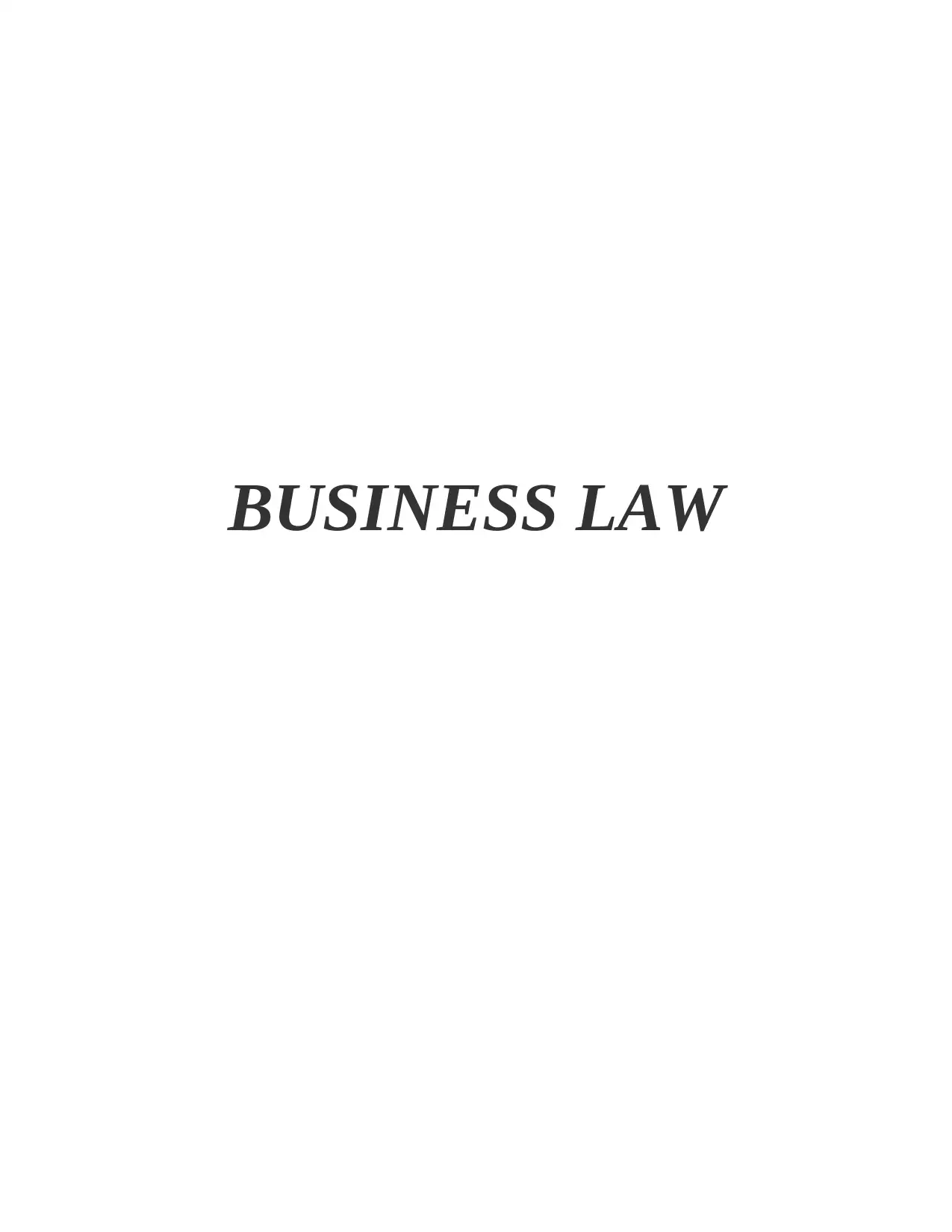
BUSINESS LAW
Paraphrase This Document
Need a fresh take? Get an instant paraphrase of this document with our AI Paraphraser
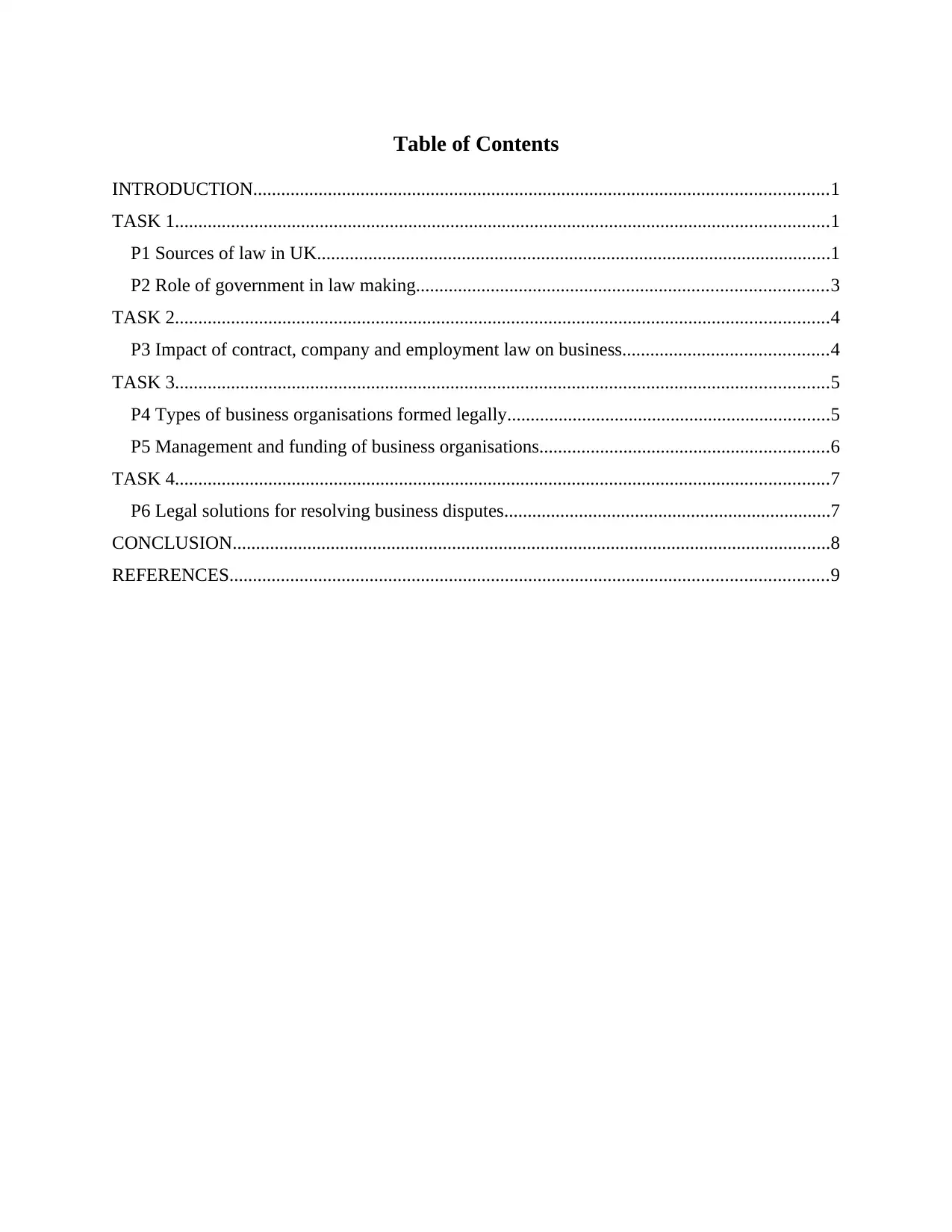
Table of Contents
INTRODUCTION...........................................................................................................................1
TASK 1............................................................................................................................................1
P1 Sources of law in UK..............................................................................................................1
P2 Role of government in law making........................................................................................3
TASK 2............................................................................................................................................4
P3 Impact of contract, company and employment law on business............................................4
TASK 3............................................................................................................................................5
P4 Types of business organisations formed legally.....................................................................5
P5 Management and funding of business organisations..............................................................6
TASK 4............................................................................................................................................7
P6 Legal solutions for resolving business disputes......................................................................7
CONCLUSION................................................................................................................................8
REFERENCES................................................................................................................................9
INTRODUCTION...........................................................................................................................1
TASK 1............................................................................................................................................1
P1 Sources of law in UK..............................................................................................................1
P2 Role of government in law making........................................................................................3
TASK 2............................................................................................................................................4
P3 Impact of contract, company and employment law on business............................................4
TASK 3............................................................................................................................................5
P4 Types of business organisations formed legally.....................................................................5
P5 Management and funding of business organisations..............................................................6
TASK 4............................................................................................................................................7
P6 Legal solutions for resolving business disputes......................................................................7
CONCLUSION................................................................................................................................8
REFERENCES................................................................................................................................9
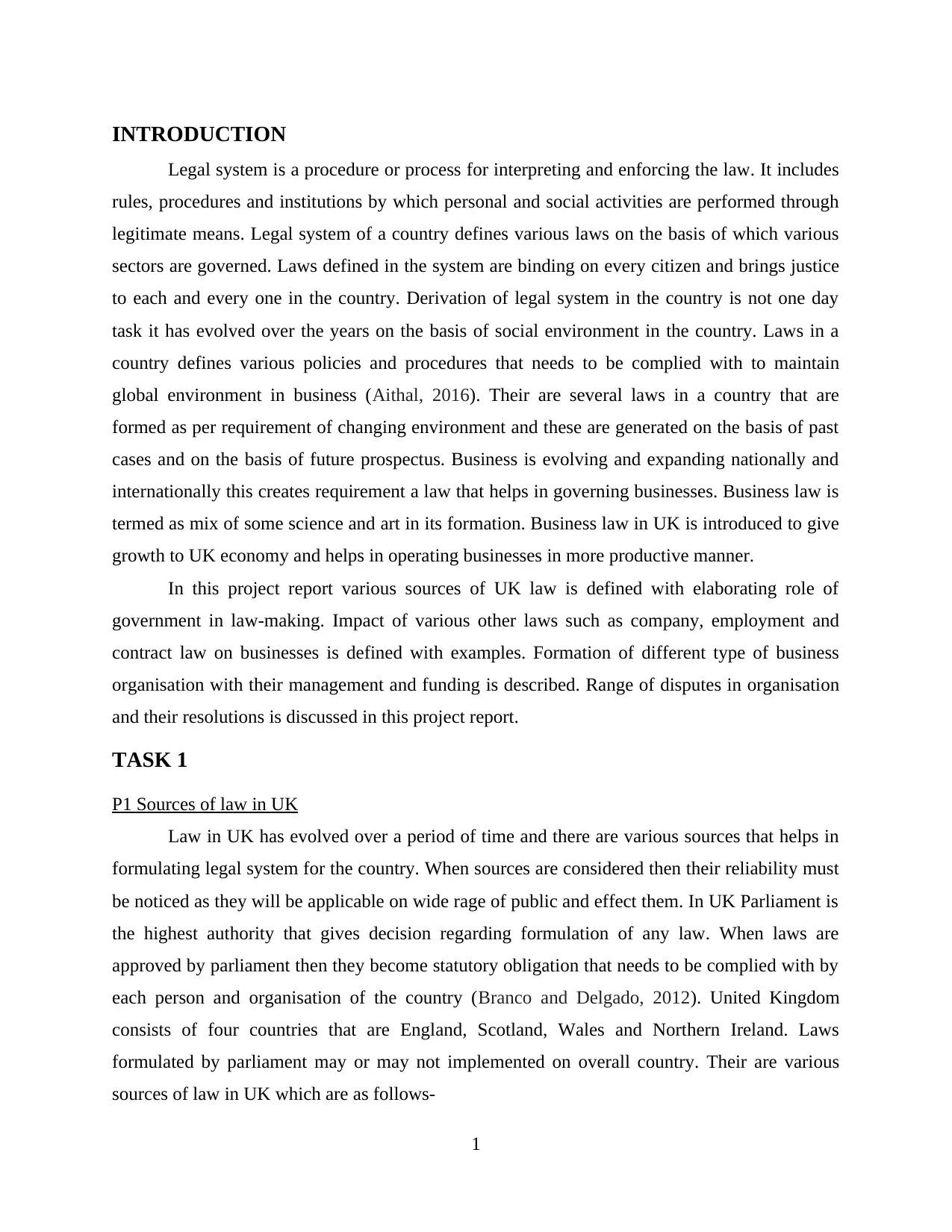
INTRODUCTION
Legal system is a procedure or process for interpreting and enforcing the law. It includes
rules, procedures and institutions by which personal and social activities are performed through
legitimate means. Legal system of a country defines various laws on the basis of which various
sectors are governed. Laws defined in the system are binding on every citizen and brings justice
to each and every one in the country. Derivation of legal system in the country is not one day
task it has evolved over the years on the basis of social environment in the country. Laws in a
country defines various policies and procedures that needs to be complied with to maintain
global environment in business (Aithal, 2016). Their are several laws in a country that are
formed as per requirement of changing environment and these are generated on the basis of past
cases and on the basis of future prospectus. Business is evolving and expanding nationally and
internationally this creates requirement a law that helps in governing businesses. Business law is
termed as mix of some science and art in its formation. Business law in UK is introduced to give
growth to UK economy and helps in operating businesses in more productive manner.
In this project report various sources of UK law is defined with elaborating role of
government in law-making. Impact of various other laws such as company, employment and
contract law on businesses is defined with examples. Formation of different type of business
organisation with their management and funding is described. Range of disputes in organisation
and their resolutions is discussed in this project report.
TASK 1
P1 Sources of law in UK
Law in UK has evolved over a period of time and there are various sources that helps in
formulating legal system for the country. When sources are considered then their reliability must
be noticed as they will be applicable on wide rage of public and effect them. In UK Parliament is
the highest authority that gives decision regarding formulation of any law. When laws are
approved by parliament then they become statutory obligation that needs to be complied with by
each person and organisation of the country (Branco and Delgado, 2012). United Kingdom
consists of four countries that are England, Scotland, Wales and Northern Ireland. Laws
formulated by parliament may or may not implemented on overall country. Their are various
sources of law in UK which are as follows-
1
Legal system is a procedure or process for interpreting and enforcing the law. It includes
rules, procedures and institutions by which personal and social activities are performed through
legitimate means. Legal system of a country defines various laws on the basis of which various
sectors are governed. Laws defined in the system are binding on every citizen and brings justice
to each and every one in the country. Derivation of legal system in the country is not one day
task it has evolved over the years on the basis of social environment in the country. Laws in a
country defines various policies and procedures that needs to be complied with to maintain
global environment in business (Aithal, 2016). Their are several laws in a country that are
formed as per requirement of changing environment and these are generated on the basis of past
cases and on the basis of future prospectus. Business is evolving and expanding nationally and
internationally this creates requirement a law that helps in governing businesses. Business law is
termed as mix of some science and art in its formation. Business law in UK is introduced to give
growth to UK economy and helps in operating businesses in more productive manner.
In this project report various sources of UK law is defined with elaborating role of
government in law-making. Impact of various other laws such as company, employment and
contract law on businesses is defined with examples. Formation of different type of business
organisation with their management and funding is described. Range of disputes in organisation
and their resolutions is discussed in this project report.
TASK 1
P1 Sources of law in UK
Law in UK has evolved over a period of time and there are various sources that helps in
formulating legal system for the country. When sources are considered then their reliability must
be noticed as they will be applicable on wide rage of public and effect them. In UK Parliament is
the highest authority that gives decision regarding formulation of any law. When laws are
approved by parliament then they become statutory obligation that needs to be complied with by
each person and organisation of the country (Branco and Delgado, 2012). United Kingdom
consists of four countries that are England, Scotland, Wales and Northern Ireland. Laws
formulated by parliament may or may not implemented on overall country. Their are various
sources of law in UK which are as follows-
1
⊘ This is a preview!⊘
Do you want full access?
Subscribe today to unlock all pages.

Trusted by 1+ million students worldwide
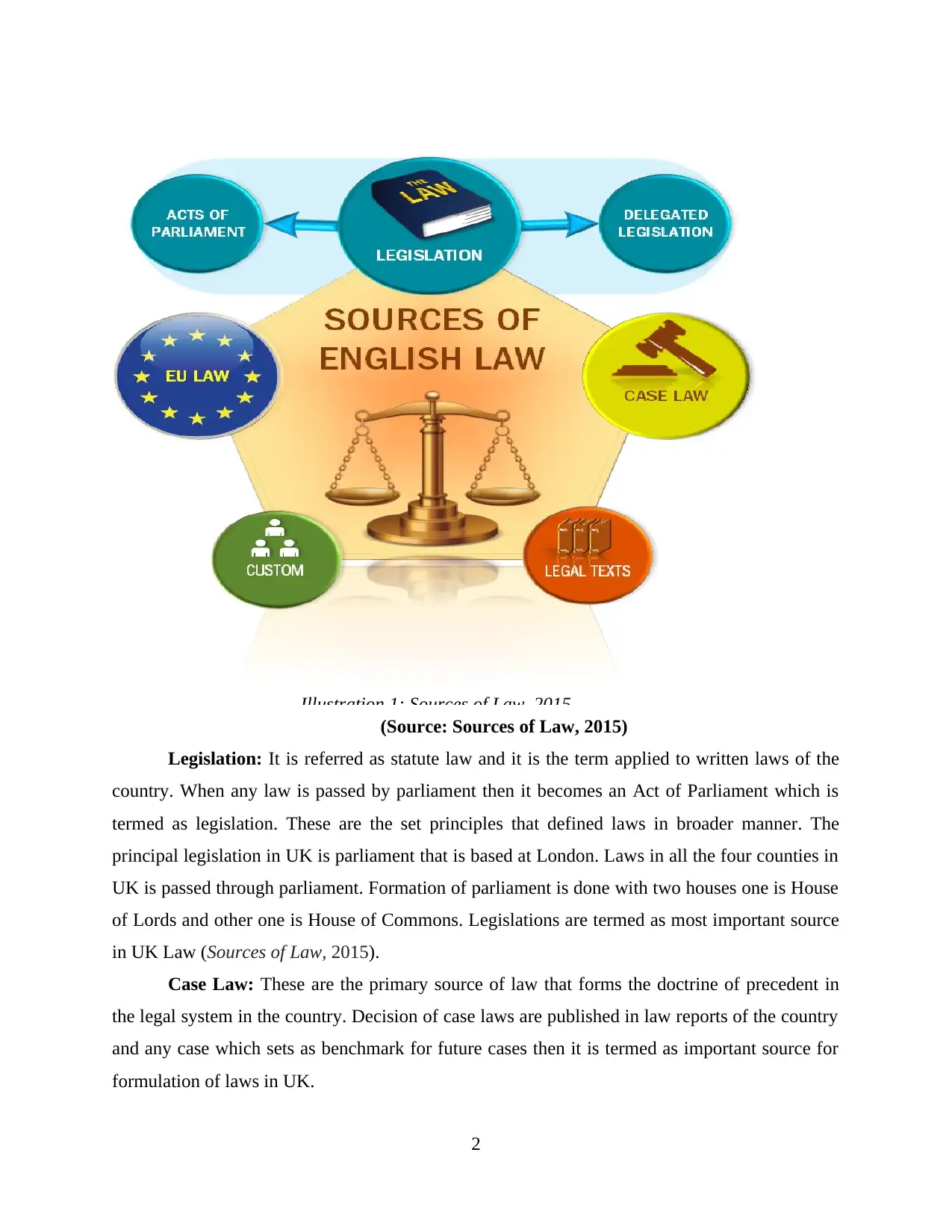
Illustration 1: Sources of Law, 2015
(Source: Sources of Law, 2015)
Legislation: It is referred as statute law and it is the term applied to written laws of the
country. When any law is passed by parliament then it becomes an Act of Parliament which is
termed as legislation. These are the set principles that defined laws in broader manner. The
principal legislation in UK is parliament that is based at London. Laws in all the four counties in
UK is passed through parliament. Formation of parliament is done with two houses one is House
of Lords and other one is House of Commons. Legislations are termed as most important source
in UK Law (Sources of Law, 2015).
Case Law: These are the primary source of law that forms the doctrine of precedent in
the legal system in the country. Decision of case laws are published in law reports of the country
and any case which sets as benchmark for future cases then it is termed as important source for
formulation of laws in UK.
2
(Source: Sources of Law, 2015)
Legislation: It is referred as statute law and it is the term applied to written laws of the
country. When any law is passed by parliament then it becomes an Act of Parliament which is
termed as legislation. These are the set principles that defined laws in broader manner. The
principal legislation in UK is parliament that is based at London. Laws in all the four counties in
UK is passed through parliament. Formation of parliament is done with two houses one is House
of Lords and other one is House of Commons. Legislations are termed as most important source
in UK Law (Sources of Law, 2015).
Case Law: These are the primary source of law that forms the doctrine of precedent in
the legal system in the country. Decision of case laws are published in law reports of the country
and any case which sets as benchmark for future cases then it is termed as important source for
formulation of laws in UK.
2
Paraphrase This Document
Need a fresh take? Get an instant paraphrase of this document with our AI Paraphraser
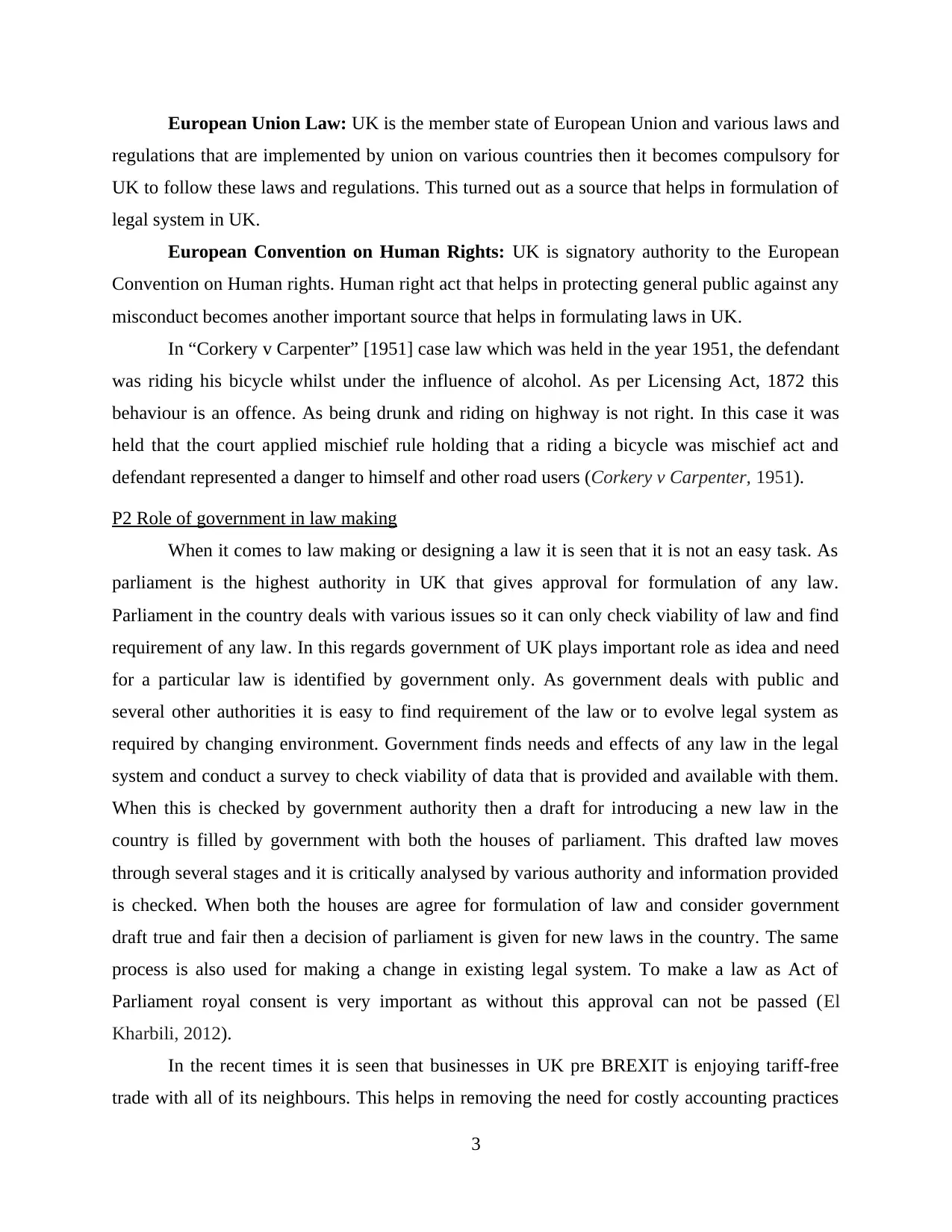
European Union Law: UK is the member state of European Union and various laws and
regulations that are implemented by union on various countries then it becomes compulsory for
UK to follow these laws and regulations. This turned out as a source that helps in formulation of
legal system in UK.
European Convention on Human Rights: UK is signatory authority to the European
Convention on Human rights. Human right act that helps in protecting general public against any
misconduct becomes another important source that helps in formulating laws in UK.
In “Corkery v Carpenter” [1951] case law which was held in the year 1951, the defendant
was riding his bicycle whilst under the influence of alcohol. As per Licensing Act, 1872 this
behaviour is an offence. As being drunk and riding on highway is not right. In this case it was
held that the court applied mischief rule holding that a riding a bicycle was mischief act and
defendant represented a danger to himself and other road users (Corkery v Carpenter, 1951).
P2 Role of government in law making
When it comes to law making or designing a law it is seen that it is not an easy task. As
parliament is the highest authority in UK that gives approval for formulation of any law.
Parliament in the country deals with various issues so it can only check viability of law and find
requirement of any law. In this regards government of UK plays important role as idea and need
for a particular law is identified by government only. As government deals with public and
several other authorities it is easy to find requirement of the law or to evolve legal system as
required by changing environment. Government finds needs and effects of any law in the legal
system and conduct a survey to check viability of data that is provided and available with them.
When this is checked by government authority then a draft for introducing a new law in the
country is filled by government with both the houses of parliament. This drafted law moves
through several stages and it is critically analysed by various authority and information provided
is checked. When both the houses are agree for formulation of law and consider government
draft true and fair then a decision of parliament is given for new laws in the country. The same
process is also used for making a change in existing legal system. To make a law as Act of
Parliament royal consent is very important as without this approval can not be passed (El
Kharbili, 2012).
In the recent times it is seen that businesses in UK pre BREXIT is enjoying tariff-free
trade with all of its neighbours. This helps in removing the need for costly accounting practices
3
regulations that are implemented by union on various countries then it becomes compulsory for
UK to follow these laws and regulations. This turned out as a source that helps in formulation of
legal system in UK.
European Convention on Human Rights: UK is signatory authority to the European
Convention on Human rights. Human right act that helps in protecting general public against any
misconduct becomes another important source that helps in formulating laws in UK.
In “Corkery v Carpenter” [1951] case law which was held in the year 1951, the defendant
was riding his bicycle whilst under the influence of alcohol. As per Licensing Act, 1872 this
behaviour is an offence. As being drunk and riding on highway is not right. In this case it was
held that the court applied mischief rule holding that a riding a bicycle was mischief act and
defendant represented a danger to himself and other road users (Corkery v Carpenter, 1951).
P2 Role of government in law making
When it comes to law making or designing a law it is seen that it is not an easy task. As
parliament is the highest authority in UK that gives approval for formulation of any law.
Parliament in the country deals with various issues so it can only check viability of law and find
requirement of any law. In this regards government of UK plays important role as idea and need
for a particular law is identified by government only. As government deals with public and
several other authorities it is easy to find requirement of the law or to evolve legal system as
required by changing environment. Government finds needs and effects of any law in the legal
system and conduct a survey to check viability of data that is provided and available with them.
When this is checked by government authority then a draft for introducing a new law in the
country is filled by government with both the houses of parliament. This drafted law moves
through several stages and it is critically analysed by various authority and information provided
is checked. When both the houses are agree for formulation of law and consider government
draft true and fair then a decision of parliament is given for new laws in the country. The same
process is also used for making a change in existing legal system. To make a law as Act of
Parliament royal consent is very important as without this approval can not be passed (El
Kharbili, 2012).
In the recent times it is seen that businesses in UK pre BREXIT is enjoying tariff-free
trade with all of its neighbours. This helps in removing the need for costly accounting practices
3
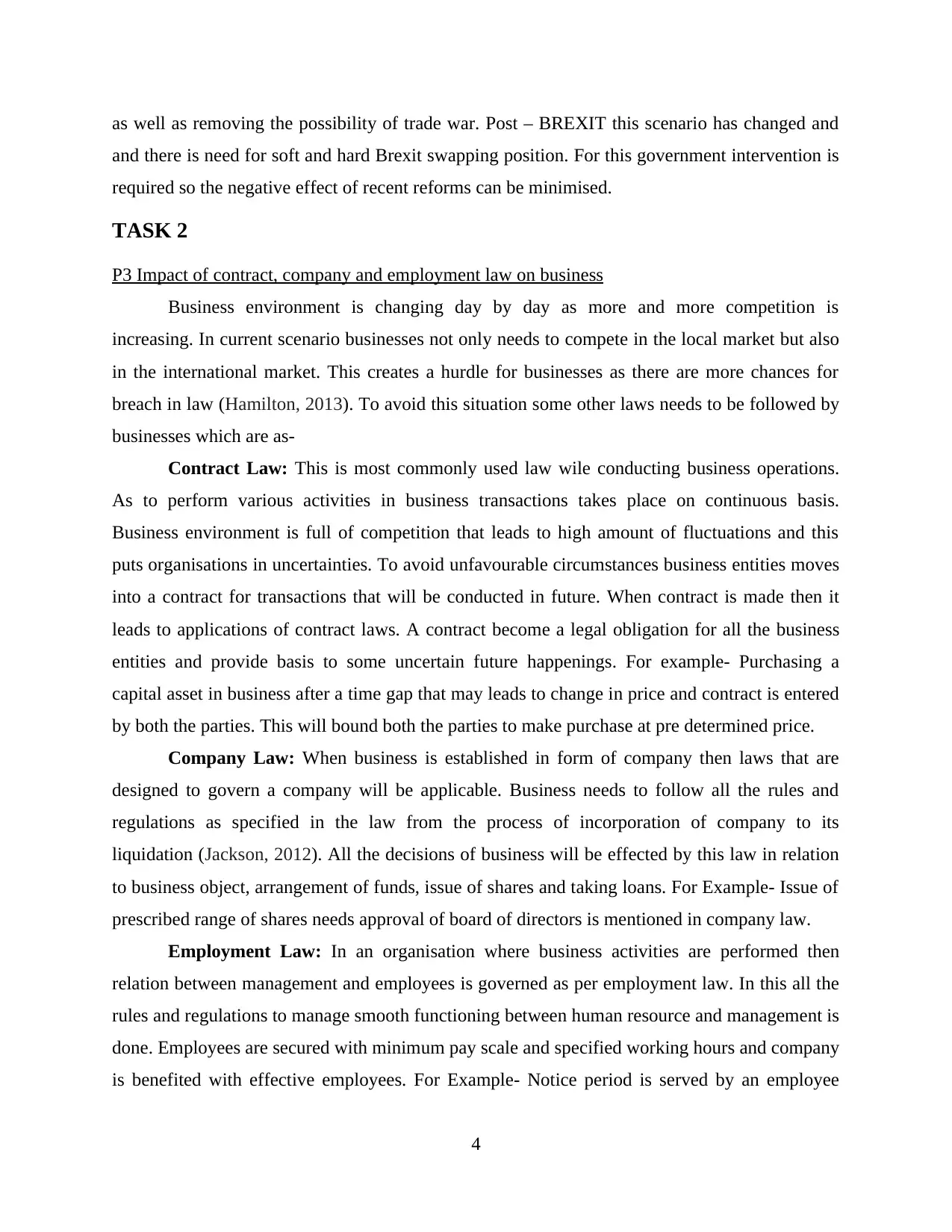
as well as removing the possibility of trade war. Post – BREXIT this scenario has changed and
and there is need for soft and hard Brexit swapping position. For this government intervention is
required so the negative effect of recent reforms can be minimised.
TASK 2
P3 Impact of contract, company and employment law on business
Business environment is changing day by day as more and more competition is
increasing. In current scenario businesses not only needs to compete in the local market but also
in the international market. This creates a hurdle for businesses as there are more chances for
breach in law (Hamilton, 2013). To avoid this situation some other laws needs to be followed by
businesses which are as-
Contract Law: This is most commonly used law wile conducting business operations.
As to perform various activities in business transactions takes place on continuous basis.
Business environment is full of competition that leads to high amount of fluctuations and this
puts organisations in uncertainties. To avoid unfavourable circumstances business entities moves
into a contract for transactions that will be conducted in future. When contract is made then it
leads to applications of contract laws. A contract become a legal obligation for all the business
entities and provide basis to some uncertain future happenings. For example- Purchasing a
capital asset in business after a time gap that may leads to change in price and contract is entered
by both the parties. This will bound both the parties to make purchase at pre determined price.
Company Law: When business is established in form of company then laws that are
designed to govern a company will be applicable. Business needs to follow all the rules and
regulations as specified in the law from the process of incorporation of company to its
liquidation (Jackson, 2012). All the decisions of business will be effected by this law in relation
to business object, arrangement of funds, issue of shares and taking loans. For Example- Issue of
prescribed range of shares needs approval of board of directors is mentioned in company law.
Employment Law: In an organisation where business activities are performed then
relation between management and employees is governed as per employment law. In this all the
rules and regulations to manage smooth functioning between human resource and management is
done. Employees are secured with minimum pay scale and specified working hours and company
is benefited with effective employees. For Example- Notice period is served by an employee
4
and there is need for soft and hard Brexit swapping position. For this government intervention is
required so the negative effect of recent reforms can be minimised.
TASK 2
P3 Impact of contract, company and employment law on business
Business environment is changing day by day as more and more competition is
increasing. In current scenario businesses not only needs to compete in the local market but also
in the international market. This creates a hurdle for businesses as there are more chances for
breach in law (Hamilton, 2013). To avoid this situation some other laws needs to be followed by
businesses which are as-
Contract Law: This is most commonly used law wile conducting business operations.
As to perform various activities in business transactions takes place on continuous basis.
Business environment is full of competition that leads to high amount of fluctuations and this
puts organisations in uncertainties. To avoid unfavourable circumstances business entities moves
into a contract for transactions that will be conducted in future. When contract is made then it
leads to applications of contract laws. A contract become a legal obligation for all the business
entities and provide basis to some uncertain future happenings. For example- Purchasing a
capital asset in business after a time gap that may leads to change in price and contract is entered
by both the parties. This will bound both the parties to make purchase at pre determined price.
Company Law: When business is established in form of company then laws that are
designed to govern a company will be applicable. Business needs to follow all the rules and
regulations as specified in the law from the process of incorporation of company to its
liquidation (Jackson, 2012). All the decisions of business will be effected by this law in relation
to business object, arrangement of funds, issue of shares and taking loans. For Example- Issue of
prescribed range of shares needs approval of board of directors is mentioned in company law.
Employment Law: In an organisation where business activities are performed then
relation between management and employees is governed as per employment law. In this all the
rules and regulations to manage smooth functioning between human resource and management is
done. Employees are secured with minimum pay scale and specified working hours and company
is benefited with effective employees. For Example- Notice period is served by an employee
4
⊘ This is a preview!⊘
Do you want full access?
Subscribe today to unlock all pages.

Trusted by 1+ million students worldwide
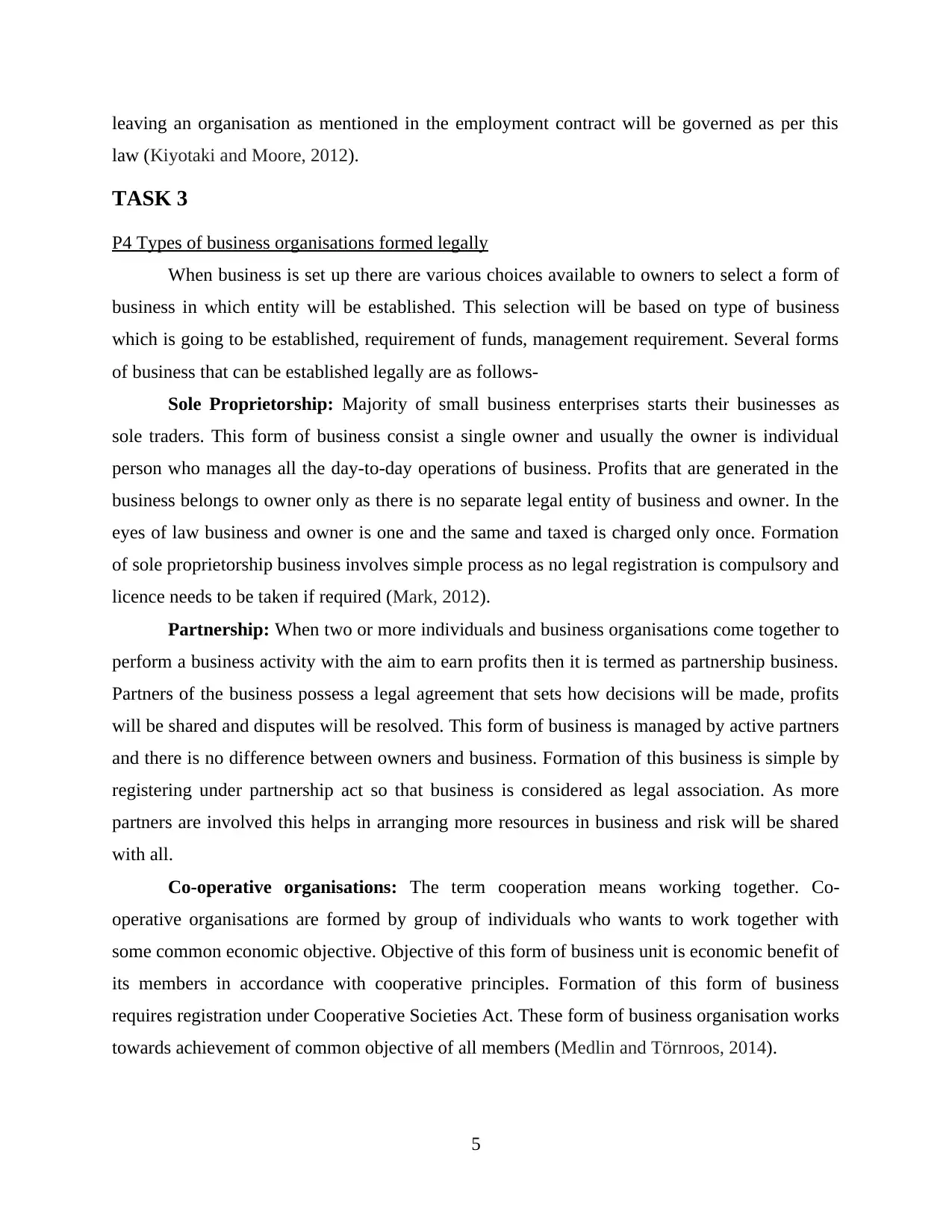
leaving an organisation as mentioned in the employment contract will be governed as per this
law (Kiyotaki and Moore, 2012).
TASK 3
P4 Types of business organisations formed legally
When business is set up there are various choices available to owners to select a form of
business in which entity will be established. This selection will be based on type of business
which is going to be established, requirement of funds, management requirement. Several forms
of business that can be established legally are as follows-
Sole Proprietorship: Majority of small business enterprises starts their businesses as
sole traders. This form of business consist a single owner and usually the owner is individual
person who manages all the day-to-day operations of business. Profits that are generated in the
business belongs to owner only as there is no separate legal entity of business and owner. In the
eyes of law business and owner is one and the same and taxed is charged only once. Formation
of sole proprietorship business involves simple process as no legal registration is compulsory and
licence needs to be taken if required (Mark, 2012).
Partnership: When two or more individuals and business organisations come together to
perform a business activity with the aim to earn profits then it is termed as partnership business.
Partners of the business possess a legal agreement that sets how decisions will be made, profits
will be shared and disputes will be resolved. This form of business is managed by active partners
and there is no difference between owners and business. Formation of this business is simple by
registering under partnership act so that business is considered as legal association. As more
partners are involved this helps in arranging more resources in business and risk will be shared
with all.
Co-operative organisations: The term cooperation means working together. Co-
operative organisations are formed by group of individuals who wants to work together with
some common economic objective. Objective of this form of business unit is economic benefit of
its members in accordance with cooperative principles. Formation of this form of business
requires registration under Cooperative Societies Act. These form of business organisation works
towards achievement of common objective of all members (Medlin and Törnroos, 2014).
5
law (Kiyotaki and Moore, 2012).
TASK 3
P4 Types of business organisations formed legally
When business is set up there are various choices available to owners to select a form of
business in which entity will be established. This selection will be based on type of business
which is going to be established, requirement of funds, management requirement. Several forms
of business that can be established legally are as follows-
Sole Proprietorship: Majority of small business enterprises starts their businesses as
sole traders. This form of business consist a single owner and usually the owner is individual
person who manages all the day-to-day operations of business. Profits that are generated in the
business belongs to owner only as there is no separate legal entity of business and owner. In the
eyes of law business and owner is one and the same and taxed is charged only once. Formation
of sole proprietorship business involves simple process as no legal registration is compulsory and
licence needs to be taken if required (Mark, 2012).
Partnership: When two or more individuals and business organisations come together to
perform a business activity with the aim to earn profits then it is termed as partnership business.
Partners of the business possess a legal agreement that sets how decisions will be made, profits
will be shared and disputes will be resolved. This form of business is managed by active partners
and there is no difference between owners and business. Formation of this business is simple by
registering under partnership act so that business is considered as legal association. As more
partners are involved this helps in arranging more resources in business and risk will be shared
with all.
Co-operative organisations: The term cooperation means working together. Co-
operative organisations are formed by group of individuals who wants to work together with
some common economic objective. Objective of this form of business unit is economic benefit of
its members in accordance with cooperative principles. Formation of this form of business
requires registration under Cooperative Societies Act. These form of business organisation works
towards achievement of common objective of all members (Medlin and Törnroos, 2014).
5
Paraphrase This Document
Need a fresh take? Get an instant paraphrase of this document with our AI Paraphraser
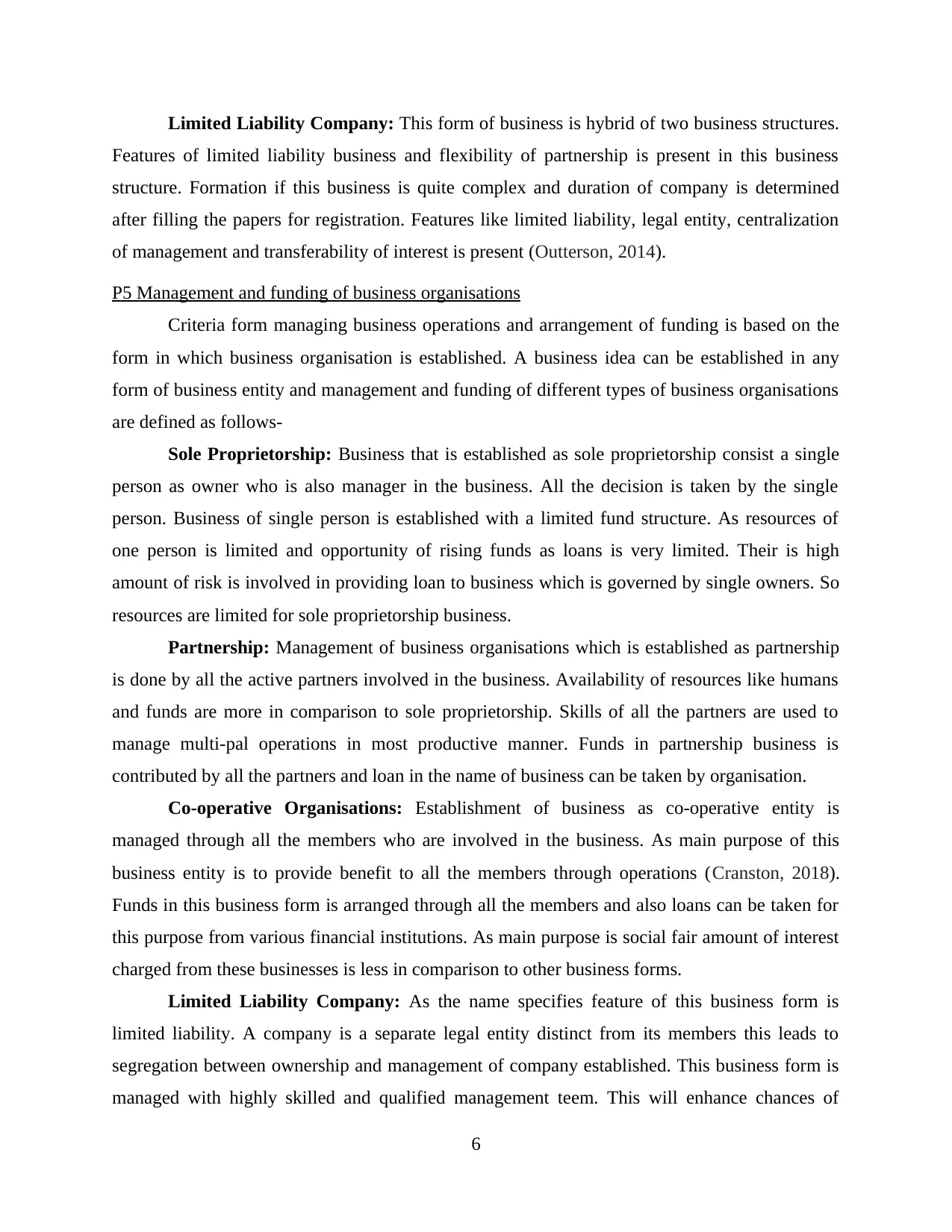
Limited Liability Company: This form of business is hybrid of two business structures.
Features of limited liability business and flexibility of partnership is present in this business
structure. Formation if this business is quite complex and duration of company is determined
after filling the papers for registration. Features like limited liability, legal entity, centralization
of management and transferability of interest is present (Outterson, 2014).
P5 Management and funding of business organisations
Criteria form managing business operations and arrangement of funding is based on the
form in which business organisation is established. A business idea can be established in any
form of business entity and management and funding of different types of business organisations
are defined as follows-
Sole Proprietorship: Business that is established as sole proprietorship consist a single
person as owner who is also manager in the business. All the decision is taken by the single
person. Business of single person is established with a limited fund structure. As resources of
one person is limited and opportunity of rising funds as loans is very limited. Their is high
amount of risk is involved in providing loan to business which is governed by single owners. So
resources are limited for sole proprietorship business.
Partnership: Management of business organisations which is established as partnership
is done by all the active partners involved in the business. Availability of resources like humans
and funds are more in comparison to sole proprietorship. Skills of all the partners are used to
manage multi-pal operations in most productive manner. Funds in partnership business is
contributed by all the partners and loan in the name of business can be taken by organisation.
Co-operative Organisations: Establishment of business as co-operative entity is
managed through all the members who are involved in the business. As main purpose of this
business entity is to provide benefit to all the members through operations (Cranston, 2018).
Funds in this business form is arranged through all the members and also loans can be taken for
this purpose from various financial institutions. As main purpose is social fair amount of interest
charged from these businesses is less in comparison to other business forms.
Limited Liability Company: As the name specifies feature of this business form is
limited liability. A company is a separate legal entity distinct from its members this leads to
segregation between ownership and management of company established. This business form is
managed with highly skilled and qualified management teem. This will enhance chances of
6
Features of limited liability business and flexibility of partnership is present in this business
structure. Formation if this business is quite complex and duration of company is determined
after filling the papers for registration. Features like limited liability, legal entity, centralization
of management and transferability of interest is present (Outterson, 2014).
P5 Management and funding of business organisations
Criteria form managing business operations and arrangement of funding is based on the
form in which business organisation is established. A business idea can be established in any
form of business entity and management and funding of different types of business organisations
are defined as follows-
Sole Proprietorship: Business that is established as sole proprietorship consist a single
person as owner who is also manager in the business. All the decision is taken by the single
person. Business of single person is established with a limited fund structure. As resources of
one person is limited and opportunity of rising funds as loans is very limited. Their is high
amount of risk is involved in providing loan to business which is governed by single owners. So
resources are limited for sole proprietorship business.
Partnership: Management of business organisations which is established as partnership
is done by all the active partners involved in the business. Availability of resources like humans
and funds are more in comparison to sole proprietorship. Skills of all the partners are used to
manage multi-pal operations in most productive manner. Funds in partnership business is
contributed by all the partners and loan in the name of business can be taken by organisation.
Co-operative Organisations: Establishment of business as co-operative entity is
managed through all the members who are involved in the business. As main purpose of this
business entity is to provide benefit to all the members through operations (Cranston, 2018).
Funds in this business form is arranged through all the members and also loans can be taken for
this purpose from various financial institutions. As main purpose is social fair amount of interest
charged from these businesses is less in comparison to other business forms.
Limited Liability Company: As the name specifies feature of this business form is
limited liability. A company is a separate legal entity distinct from its members this leads to
segregation between ownership and management of company established. This business form is
managed with highly skilled and qualified management teem. This will enhance chances of
6
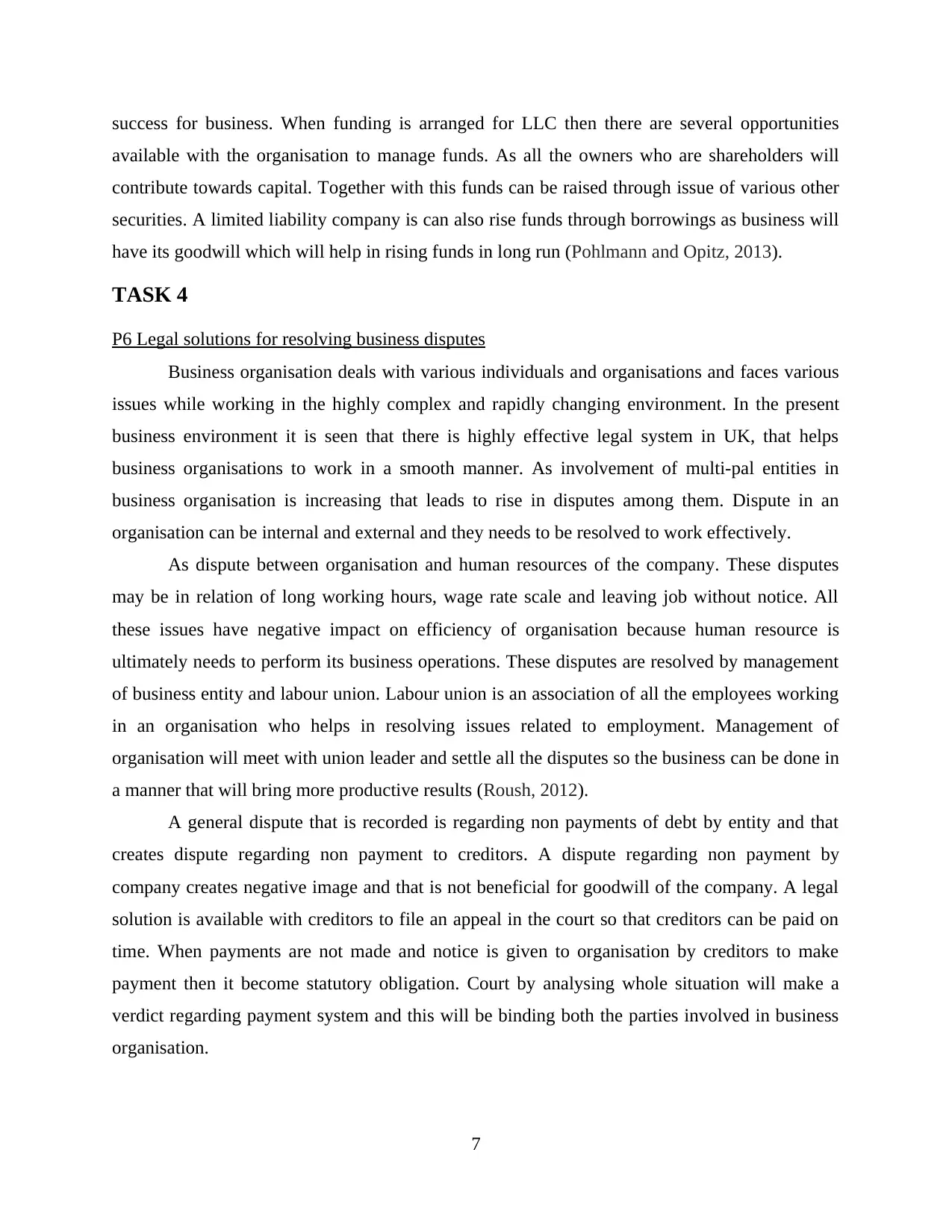
success for business. When funding is arranged for LLC then there are several opportunities
available with the organisation to manage funds. As all the owners who are shareholders will
contribute towards capital. Together with this funds can be raised through issue of various other
securities. A limited liability company is can also rise funds through borrowings as business will
have its goodwill which will help in rising funds in long run (Pohlmann and Opitz, 2013).
TASK 4
P6 Legal solutions for resolving business disputes
Business organisation deals with various individuals and organisations and faces various
issues while working in the highly complex and rapidly changing environment. In the present
business environment it is seen that there is highly effective legal system in UK, that helps
business organisations to work in a smooth manner. As involvement of multi-pal entities in
business organisation is increasing that leads to rise in disputes among them. Dispute in an
organisation can be internal and external and they needs to be resolved to work effectively.
As dispute between organisation and human resources of the company. These disputes
may be in relation of long working hours, wage rate scale and leaving job without notice. All
these issues have negative impact on efficiency of organisation because human resource is
ultimately needs to perform its business operations. These disputes are resolved by management
of business entity and labour union. Labour union is an association of all the employees working
in an organisation who helps in resolving issues related to employment. Management of
organisation will meet with union leader and settle all the disputes so the business can be done in
a manner that will bring more productive results (Roush, 2012).
A general dispute that is recorded is regarding non payments of debt by entity and that
creates dispute regarding non payment to creditors. A dispute regarding non payment by
company creates negative image and that is not beneficial for goodwill of the company. A legal
solution is available with creditors to file an appeal in the court so that creditors can be paid on
time. When payments are not made and notice is given to organisation by creditors to make
payment then it become statutory obligation. Court by analysing whole situation will make a
verdict regarding payment system and this will be binding both the parties involved in business
organisation.
7
available with the organisation to manage funds. As all the owners who are shareholders will
contribute towards capital. Together with this funds can be raised through issue of various other
securities. A limited liability company is can also rise funds through borrowings as business will
have its goodwill which will help in rising funds in long run (Pohlmann and Opitz, 2013).
TASK 4
P6 Legal solutions for resolving business disputes
Business organisation deals with various individuals and organisations and faces various
issues while working in the highly complex and rapidly changing environment. In the present
business environment it is seen that there is highly effective legal system in UK, that helps
business organisations to work in a smooth manner. As involvement of multi-pal entities in
business organisation is increasing that leads to rise in disputes among them. Dispute in an
organisation can be internal and external and they needs to be resolved to work effectively.
As dispute between organisation and human resources of the company. These disputes
may be in relation of long working hours, wage rate scale and leaving job without notice. All
these issues have negative impact on efficiency of organisation because human resource is
ultimately needs to perform its business operations. These disputes are resolved by management
of business entity and labour union. Labour union is an association of all the employees working
in an organisation who helps in resolving issues related to employment. Management of
organisation will meet with union leader and settle all the disputes so the business can be done in
a manner that will bring more productive results (Roush, 2012).
A general dispute that is recorded is regarding non payments of debt by entity and that
creates dispute regarding non payment to creditors. A dispute regarding non payment by
company creates negative image and that is not beneficial for goodwill of the company. A legal
solution is available with creditors to file an appeal in the court so that creditors can be paid on
time. When payments are not made and notice is given to organisation by creditors to make
payment then it become statutory obligation. Court by analysing whole situation will make a
verdict regarding payment system and this will be binding both the parties involved in business
organisation.
7
⊘ This is a preview!⊘
Do you want full access?
Subscribe today to unlock all pages.

Trusted by 1+ million students worldwide
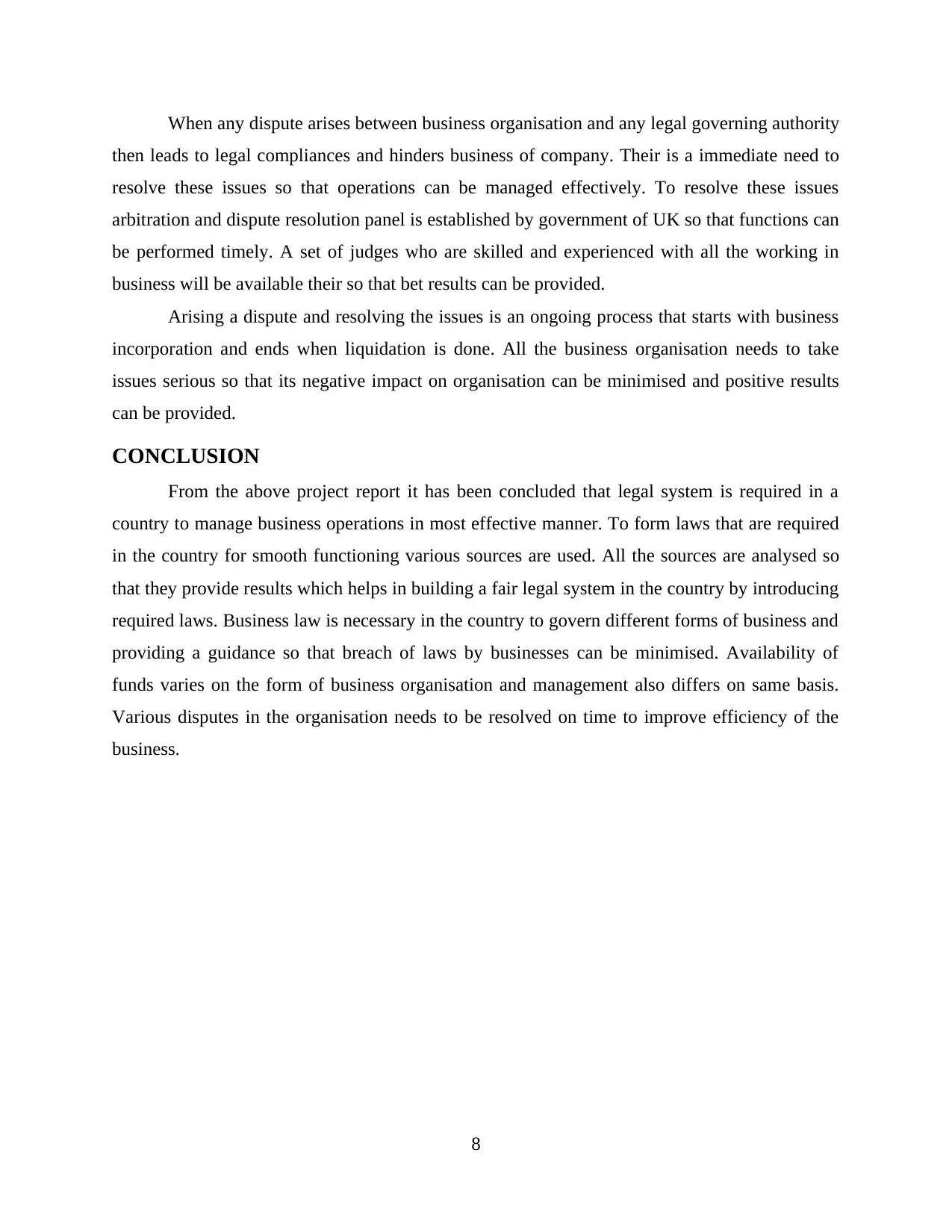
When any dispute arises between business organisation and any legal governing authority
then leads to legal compliances and hinders business of company. Their is a immediate need to
resolve these issues so that operations can be managed effectively. To resolve these issues
arbitration and dispute resolution panel is established by government of UK so that functions can
be performed timely. A set of judges who are skilled and experienced with all the working in
business will be available their so that bet results can be provided.
Arising a dispute and resolving the issues is an ongoing process that starts with business
incorporation and ends when liquidation is done. All the business organisation needs to take
issues serious so that its negative impact on organisation can be minimised and positive results
can be provided.
CONCLUSION
From the above project report it has been concluded that legal system is required in a
country to manage business operations in most effective manner. To form laws that are required
in the country for smooth functioning various sources are used. All the sources are analysed so
that they provide results which helps in building a fair legal system in the country by introducing
required laws. Business law is necessary in the country to govern different forms of business and
providing a guidance so that breach of laws by businesses can be minimised. Availability of
funds varies on the form of business organisation and management also differs on same basis.
Various disputes in the organisation needs to be resolved on time to improve efficiency of the
business.
8
then leads to legal compliances and hinders business of company. Their is a immediate need to
resolve these issues so that operations can be managed effectively. To resolve these issues
arbitration and dispute resolution panel is established by government of UK so that functions can
be performed timely. A set of judges who are skilled and experienced with all the working in
business will be available their so that bet results can be provided.
Arising a dispute and resolving the issues is an ongoing process that starts with business
incorporation and ends when liquidation is done. All the business organisation needs to take
issues serious so that its negative impact on organisation can be minimised and positive results
can be provided.
CONCLUSION
From the above project report it has been concluded that legal system is required in a
country to manage business operations in most effective manner. To form laws that are required
in the country for smooth functioning various sources are used. All the sources are analysed so
that they provide results which helps in building a fair legal system in the country by introducing
required laws. Business law is necessary in the country to govern different forms of business and
providing a guidance so that breach of laws by businesses can be minimised. Availability of
funds varies on the form of business organisation and management also differs on same basis.
Various disputes in the organisation needs to be resolved on time to improve efficiency of the
business.
8
Paraphrase This Document
Need a fresh take? Get an instant paraphrase of this document with our AI Paraphraser
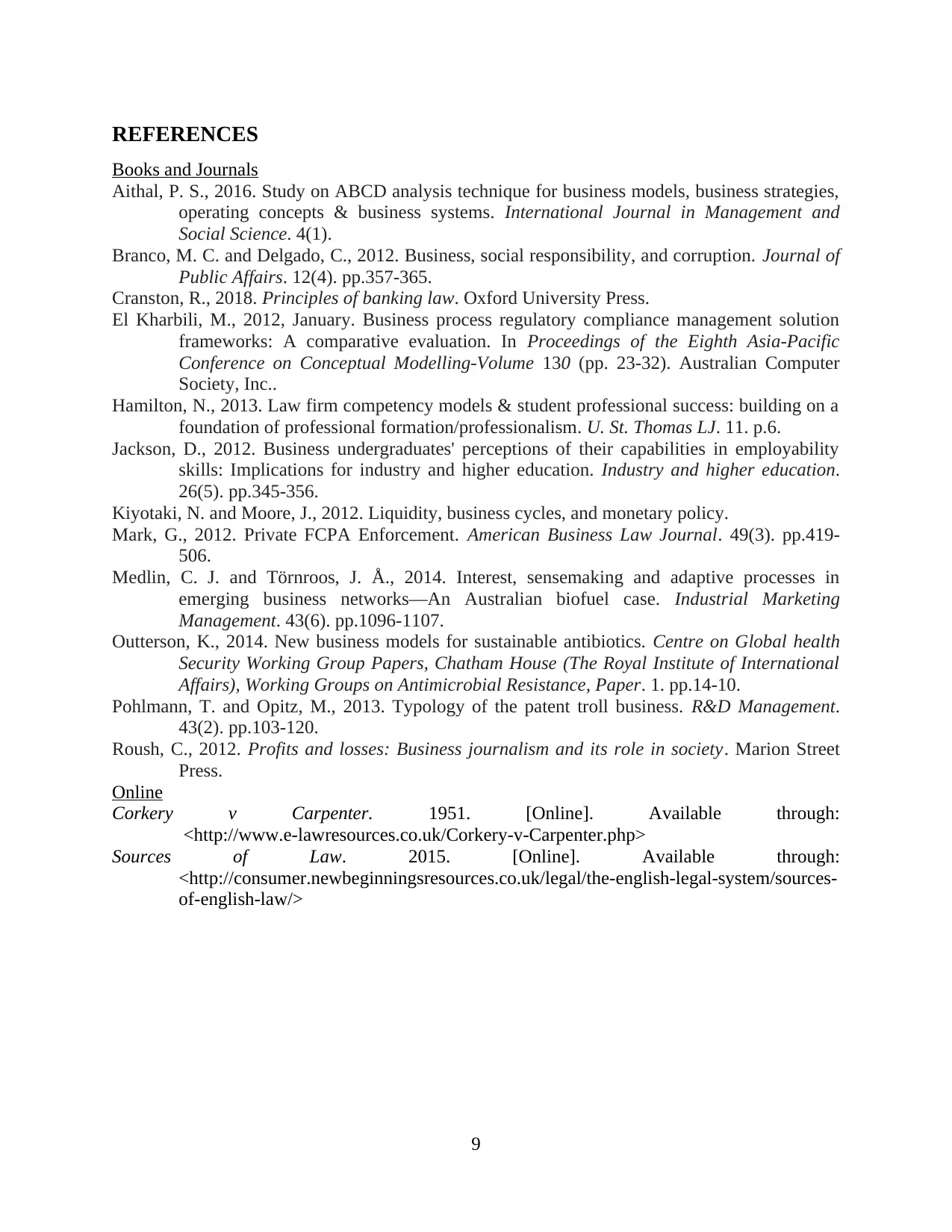
REFERENCES
Books and Journals
Aithal, P. S., 2016. Study on ABCD analysis technique for business models, business strategies,
operating concepts & business systems. International Journal in Management and
Social Science. 4(1).
Branco, M. C. and Delgado, C., 2012. Business, social responsibility, and corruption. Journal of
Public Affairs. 12(4). pp.357-365.
Cranston, R., 2018. Principles of banking law. Oxford University Press.
El Kharbili, M., 2012, January. Business process regulatory compliance management solution
frameworks: A comparative evaluation. In Proceedings of the Eighth Asia-Pacific
Conference on Conceptual Modelling-Volume 130 (pp. 23-32). Australian Computer
Society, Inc..
Hamilton, N., 2013. Law firm competency models & student professional success: building on a
foundation of professional formation/professionalism. U. St. Thomas LJ. 11. p.6.
Jackson, D., 2012. Business undergraduates' perceptions of their capabilities in employability
skills: Implications for industry and higher education. Industry and higher education.
26(5). pp.345-356.
Kiyotaki, N. and Moore, J., 2012. Liquidity, business cycles, and monetary policy.
Mark, G., 2012. Private FCPA Enforcement. American Business Law Journal. 49(3). pp.419-
506.
Medlin, C. J. and Törnroos, J. Å., 2014. Interest, sensemaking and adaptive processes in
emerging business networks—An Australian biofuel case. Industrial Marketing
Management. 43(6). pp.1096-1107.
Outterson, K., 2014. New business models for sustainable antibiotics. Centre on Global health
Security Working Group Papers, Chatham House (The Royal Institute of International
Affairs), Working Groups on Antimicrobial Resistance, Paper. 1. pp.14-10.
Pohlmann, T. and Opitz, M., 2013. Typology of the patent troll business. R&D Management.
43(2). pp.103-120.
Roush, C., 2012. Profits and losses: Business journalism and its role in society. Marion Street
Press.
Online
Corkery v Carpenter. 1951. [Online]. Available through:
<http://www.e-lawresources.co.uk/Corkery-v-Carpenter.php>
Sources of Law. 2015. [Online]. Available through:
<http://consumer.newbeginningsresources.co.uk/legal/the-english-legal-system/sources-
of-english-law/>
9
Books and Journals
Aithal, P. S., 2016. Study on ABCD analysis technique for business models, business strategies,
operating concepts & business systems. International Journal in Management and
Social Science. 4(1).
Branco, M. C. and Delgado, C., 2012. Business, social responsibility, and corruption. Journal of
Public Affairs. 12(4). pp.357-365.
Cranston, R., 2018. Principles of banking law. Oxford University Press.
El Kharbili, M., 2012, January. Business process regulatory compliance management solution
frameworks: A comparative evaluation. In Proceedings of the Eighth Asia-Pacific
Conference on Conceptual Modelling-Volume 130 (pp. 23-32). Australian Computer
Society, Inc..
Hamilton, N., 2013. Law firm competency models & student professional success: building on a
foundation of professional formation/professionalism. U. St. Thomas LJ. 11. p.6.
Jackson, D., 2012. Business undergraduates' perceptions of their capabilities in employability
skills: Implications for industry and higher education. Industry and higher education.
26(5). pp.345-356.
Kiyotaki, N. and Moore, J., 2012. Liquidity, business cycles, and monetary policy.
Mark, G., 2012. Private FCPA Enforcement. American Business Law Journal. 49(3). pp.419-
506.
Medlin, C. J. and Törnroos, J. Å., 2014. Interest, sensemaking and adaptive processes in
emerging business networks—An Australian biofuel case. Industrial Marketing
Management. 43(6). pp.1096-1107.
Outterson, K., 2014. New business models for sustainable antibiotics. Centre on Global health
Security Working Group Papers, Chatham House (The Royal Institute of International
Affairs), Working Groups on Antimicrobial Resistance, Paper. 1. pp.14-10.
Pohlmann, T. and Opitz, M., 2013. Typology of the patent troll business. R&D Management.
43(2). pp.103-120.
Roush, C., 2012. Profits and losses: Business journalism and its role in society. Marion Street
Press.
Online
Corkery v Carpenter. 1951. [Online]. Available through:
<http://www.e-lawresources.co.uk/Corkery-v-Carpenter.php>
Sources of Law. 2015. [Online]. Available through:
<http://consumer.newbeginningsresources.co.uk/legal/the-english-legal-system/sources-
of-english-law/>
9
1 out of 11
Related Documents
Your All-in-One AI-Powered Toolkit for Academic Success.
+13062052269
info@desklib.com
Available 24*7 on WhatsApp / Email
![[object Object]](/_next/static/media/star-bottom.7253800d.svg)
Unlock your academic potential
Copyright © 2020–2025 A2Z Services. All Rights Reserved. Developed and managed by ZUCOL.




